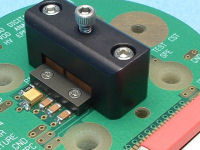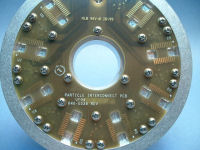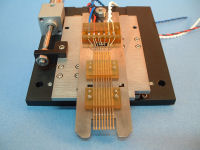Informative Links
- Test Fixture and MEMS Test Fixture Design
- Circuit Design
- Semiconductor Fab Equipment Design
- Instrument Design for the Chemical, Biotech and Life Sciences Industry
Portfolio of
Example Projects

Manual single site MEMS linear accelerometer test fixture

Top view of 8 site MEMS angular accelerometer contactor PCB

Automated contactor for high current LED testing
Electronic and Electro-Mechanical Test Fixtures
Introduction
Henning Engineering has extensive experience designing test fixtures for a wide variety of electronic components. We specialize in designing custom test fixtures for applications where a standard bed of nails or IC contactor type of solution is not possible. Many customers come to us because they cannot find a solution from any other vendor.
Some examples of test fixtures we have designed include:
- MEMS inertial sensors such as accelerometers, multi-axis accelerometers, gyroscopes, and rate sensors
- MEMS pressure sensors
- Optical MEMS
- Pressure sensors
- High power LEDs and LED arrays
- Test fixtures that operate under pressure or in vacuum
- Water cooled test fixtures for high power devices
- Fixtures for testing RF devices and circuit assemblies requiring high frequency probing
All of these examples have one thing in common: the input or output of the device is not electrical, the device has to be tested in a special environment, or the device has some special requirements that require strong electro-mechanical design skills. Often the test fixture is the weak link in the test system for testing these types of devices. Many customers have come to us with test systems that were completely functional but lacking a working test fixture solution.
Design of test fixtures for applications like these require a lot of creativity and very close coordination between the electrical design and the mechanical design. It is precisely this type of design work that is Henning Engineering's greatest strength. We can provide seamless integration of the test fixture components resulting in a fixture design unmatched by anyone.
MEMS Test Fixtures
Testing MEMS poses a unique challenge since you are testing the electrical response to mechanical phenomena. This is a critical problem since the mechanical stimulus occurs on a much larger time scale. Testing pressure devices is a good example. For this reason, testing devices in parallel is highly desirable and the more the better. Our skill at seamlessly integrating mechanical and electrical design allows us to produce clean multi-site fixture designs that perform smoothly and jam free at high speed of operation.
In the case of inertial sensors we have developed a proprietary design for actuating the fixture that drastically decreases its overall mass while at the same time reduces the overall size. This maximizes the modulus to density ratio of the fixture high resulting in a superior fixture design.
Engineering Test Fixtures
Often customers will have us first design a single site test fixture that is manually operated. This type of fixture, often called an engineering test fixture, is simpler than a production fixture and the lead time to design and build is much shorter. The benefits of this type of fixture include:
- Short lead time to manufacture - 3-4 weeks
- Can be used for device characterization and qualification
- Can be used to evaluate and debug the test system electronics and test program
- For devices such as accelerometers the fixture can easily be oriented to evaluate the cross axis response of the part
- Fixture cost is substantially less than a multi-site production fixture
- Can be pressed into service to produce small pilot production volumes quickly if necessary
- Does not require an IC handler to operate
After successful testing and evaluation of the part using
the engineering fixture, a multi-site fixture for production is then
designed.
Test Head Interface
Test fixtures will often require some additional design to properly interface to the test electronics. If the customer already has a test system we can design an interface. We have designed hardware to interface fixtures with commercially available IC testers, rack mounted VXI/PXI test equipment, and custom designed testers. Using test electronics that the customer already has, and is familiar with, is often the fastest way to a working solution. Also some DUTs will require special electronics to be designed and located as close as possible to the test fixture. We have designed custom load boards, redesigned test heads, modified test head sheet metal enclosures, and designed special cabling including interfacing through temperature chambers to meet these requirements.